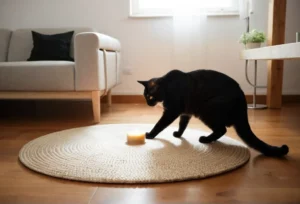Cats are known for their quirky behavior, and one common puzzling phenomenon that many cat owners have observed is their tendency to run around like crazy after eating. But why do cats do this? Let’s explore the reasons behind this amusing behavior.
Upon finishing their meal, cats often exhibit a burst of energy and start running around the house. This behavior can be confusing for pet owners, but there are some explanations for why cats engage in this post-dinner sprint.
Cats Run After Eating to Aid Digestion
Increased Blood Flow to Aid Digestion
After your feline friend scarfs down their meal, you may notice them darting off in a burst of energy. This seemingly peculiar behavior actually serves a purpose. Increased blood flow to the stomach helps aid digestion. By getting up and moving around, cats help promote the flow of blood to their stomach, assisting in breaking down the food they’ve just consumed. This physical activity can also prevent issues like bloating or indigestion. So, the next time your cat zooms off after a meal, know that they’re just helping their body process that delicious feast!
Instinctual Behavior
Cats are known for their hunting prowess, and this instinctual behavior of running after eating may actually be a remnant of their wild instincts. In the wild, cats would need to hunt for their next meal after consuming their previous one. This innate behavior may still kick in for our domesticated feline friends, leading them to dash around post-meal. So, when your cat zooms past you after finishing their food, it’s not just random energy bursts—it’s their inner hunter coming out!
Unique Insight: Meal Protection Mode
In addition to aiding digestion and tapping into their hunting instincts, cats may also run after eating to go into a sort of “meal protection mode.” In the wild, speed is crucial for survival, and by finishing their meal quickly and then running off, cats may be mimicking behaviors to protect their food from potential predators or other competitors. This unique insight provides a fascinating glimpse into the complex behaviors and instincts of our beloved feline companions. Keep an eye out for this intriguing behavior next time your cat finishes their meal!
Playful Behavior
After a hearty meal, some cats may feel a burst of energy, leading them to engage in playful behavior. You might notice your feline friend darting around the house, chasing toys, or even inviting you to join in on the fun. This post-dining play session is a way for cats to burn off excess energy and calories, keeping them active and entertained. Encouraging playtime after meals can help prevent boredom and promote a healthy lifestyle for your furry companion.
Prevent Predators
In the wild, a cat’s natural instinct is to avoid drawing attention to itself after eating to prevent attracting potential predators. By running after a meal, cats aim to disperse any lingering food scents and reduce the risk of being detected by larger animals. This behavior helps keep them safe in their environment and minimizes the chances of becoming prey. While your indoor cat may not face the same predator threat, this ingrained behavior remains a part of their instincts. – Additionally, providing multiple small meals throughout the day can mimic a cat’s natural feeding habits in the wild, reducing the urge to run after eating to prevent attracting predators.
For more tips on enriching your cat’s post-meal routine, check out this helpful resource on interactive toys for indoor cats: Interactive Toys for Indoor Cats
Marking Territory
After eating, cats may engage in running around to mark their territory. Cats have scent glands in their paw pads, cheeks, and around their face, so when they run around, they spread their scent as a way of claiming their space. This behavior is instinctual and helps them communicate with other cats in the household. If you notice your cat running around after a meal, it’s likely their way of saying, “This place is mine!”
Fun Facts About Cat Behavior
- Cats’ Whiskers are Super Sensitive: Whiskers are not just for show; they are incredibly sensitive and help cats navigate their environment. They can even pick up on subtle changes in the air, allowing your cat to gauge the size of openings and spaces.
- Purring is Multifunctional: While cats are often associated with being content when they purr, they also purr when they’re feeling anxious or in pain. It’s their way of comforting themselves, kind of like a self-soothing mechanism.
- Kneading is a Sign of Comfort: When your cat kneads you with their paws, it’s a behavior that harkens back to their kittenhood. It’s a sign of comfort and contentment, as kittens knead their mother’s belly to stimulate milk flow while nursing.
Alex, a passionate animal lover, has experience in training and understanding animal behavior. As a proud pet parent to two dogs and three cats, he founded AnimalReport.net to share insights from animal experts and expand his knowledge of the animal kingdom.




